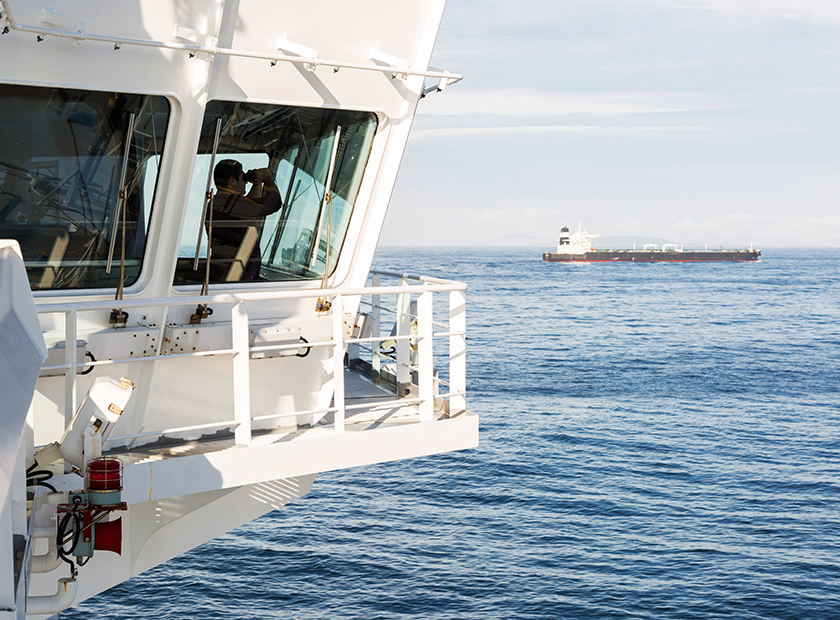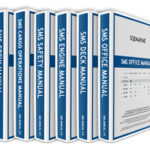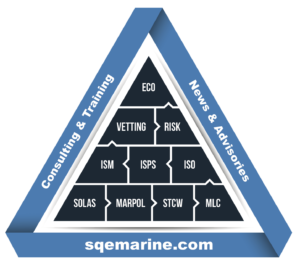Overview
In January 2022, the International Chamber of Shipping (ICS) published the new edition (6th) of the Bridge Procedures Guide, seven years after the previous edition. Bridge procedure guide is an edition globally accepted as an industry’s best practice for bridge procedures.
What’s new?
The new edition has incorporated some additional guidance for electronic navigation, including screen shots of several equipment displays in order to explain more effectively items related to e-navigation and bridge digitalization. In particular:
- In the new edition, the introduction has been numbered as Chapter 1, hence all other chapters have been renumbered accordingly.
- Instead of Annexes, the new edition uses Appendices.
- Screenshots and posters have been incorporated in several chapters.
- In most checklists, the column Status and Remarks have been incorporated.
- Checklists are renumbered as follows:
| Checklists | Old edition (5th) | New Edition (6th) |
| Pilotage | A1 to A3 | C1.1 to C1.4 |
| Bridge | B1 to B19 | C2.1 to C2.19 |
| Emergency | C1 to C10 | C3.1 to C3.11 |
Main Text differences
Chapter 1 Introduction: In 5th edition (old), the Master had the responsibility of checking Passage Plan prior approving it. In 6th edition, the passage plan is to be checked by the officer responsible for navigation, and Master to review and approve the plan. Additionally, there is a new requirement mentioning that the familiarization with navigational equipment should be included in SMS; however, most Companies already comply with this.
Chapter 2 Effective Bridge Organization: Some additional requirements have been incorporated in several paragraphs of the chapter
- New section in paragraph 2.2.5 Bridge Team leadership, resource management and team work, regarding Challenge Decisions has been incorporated. Challenge decisions were referred in previous edition without any explanation but in the new edition, some examples are used to highlight the technic under the remark that ‘’Challenge and response approach should not under any circumstances be considered undermining the authority delegated to OOW by the Master”.
- New paragraphs 2.2.6 Bridge Team human element and 2.2.7 Briefing and Debriefing, have been incorporated to enhance the safety environment and behavior within bridge team.
- In para 2.3.2 Orders, the use of night order book has been incorporated as well.
Chapter 3 Passage Planning: Some additional comments have been incorporated in several sections. However, the 4 stages of achieving safe passage planning remain the same (Appraisal, Planning, Execution, Monitoring).
- In para 3.4.3 the wording for Pilotage Plan has been removed and replaced by Passage Plan. In conjunction with introduction para. 1.5 Pilotage in which the requirement of previous (5th) edition of “ ..pilotage to be conducted within the established safe limits identified in passage plan”, creates a new approach for pilotage.
- Para. 3.4.4 Passage planning with ECDIS, revised to include additional guidance, has been incorporated regarding ECDIS safety settings. The calculation formula for safety contour has been included. An additional requirement for SMS to include UKC policy under different values of CATZOC, has been added.
- New para. 3.4.7 Weather Routing has been added.
Chapter 4 Duties of OOW: Some additional comments have been added in several sections of the chapter.
- In para. 4.4.1 Control of night vision, the consideration of darkening externally facing accommodation windows has been added.
- New para. 4.9 Communication with Engine Control Room has been incorporated (to support relevant para. 4.4 of Engine Room Procedure Guide).
- New para. 4.11 Cargo Operations has been added
- New para. 4.12 Risk Assessment has been added
- New para. 4.13 Ship Stability has been added
- In para. 4.14.4 Steering Control and additional requirement for manual steering when ship is maneuvered or under pilotage has been included.
- New para. 4.21.1 Pollution by oil or Harmful Substances has been added.
- New para. 4.21.4 Other sources of pollution has been added
- New para. 4.21.5 Energy Efficiency has been added
- New par. 4.21.6 Ballast Water Management has been added.
Chapter 5 Operation & maintenance of bridge Equipment: Some additional comments have been included
- New para. 5.11 Radar characteristics has been added.
- In para. 5.13.2 Chart Updates the provision for Cyber Security has been added.
Chapter 6 Pilotage: Some additional items have been incorporated in several sections of the chapter.
- In para. 6.2.1 Passage Plan the provision for amending the passage plan after discussion with the pilot notifying the OOW accordingly, has been included.
- In para. 6.2.2 The Ship & Bridge team, the wording for pilotage plan has been removed.
Appendix C Checklists
- C3 Emergencies: Almost all emergency Checklists have been revised
- New C3.11 Checklist Rescue in enclosed spaces has been added.
Key Highlights
The new edition of ICS Bridge Procedure Guide arises some interesting issues and highlights:
- The structure ha been changed to align with the engine room procedure guide
- Additional safety issues have been included, concerning mostly general ship’s safety and not exclusively Bridge safety (Risk assessment/Permit to work system etc)
- Several new paragraphs were added in Chapter 4 Duties of OOW, however these are mostly theoretical and not operational (energy efficiency/ballast management/SOPEP/SEEMP etc). The typical operational duties of OOW remained unchanged. Additional Cargo Operations and stability issues were already approached by Companies (through SMS) for the OOW.
- The main change has been made in the pilotage. In particular, the wording ‘Pilotage plan’ has been removed so the Master and the Pilot to discuss and modify (if necessary) the passage plan (as per para 3.4.3). However, taking into consideration that in introduction para. 1.5 the wording of previous (5th) edition of “ ..pilotage to be conducted within the established safe limits identified in passage plan” has been removed, this may create misunderstanding. Nonetheless, an effective Master/Pilot exchange, will provide the necessary information on how to modify the passage plan for the pilotage, using as a tool the briefing of the bridge team for the specific stage. It is vital that all bridge team (including Master and Pilot) know exactly the plan and the actions to be conducted for the safety of the crew, ship, cargo and environment.
Actions required
Ship managers and operators should be aware of the revised ICS Bridge Procedure guide. Hence, some sections of SMS may require modification or revision in order to include new items featured in the Guide as the edition is commonly accepted as industry’s best practice. Specially, issues related with ECDIS navigation and safety settings need to be reconsidered in order to clarify to bridge teams the limits, the advantages and disadvantages of over-reliance when it comes to electronic navigation and bridge digitalization. Additionally, the Emergency Checklists need to be revised to include new items introduced.
You may also find further information on the New Bridge Procedure Guide at SAFETY4SEA
How we may help
SQEMARINE can provide guidance and revise the existing SMS to include the requirements of the new edition.



